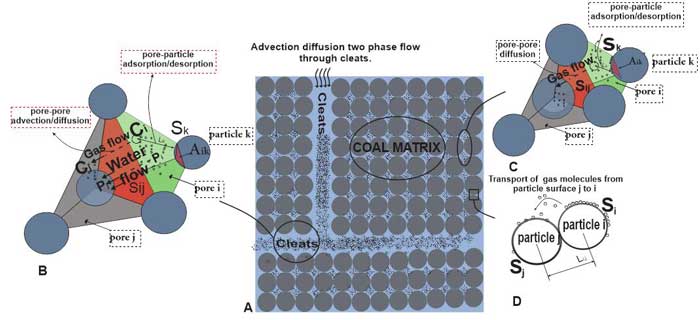Multi-scale hydro-mechanical modeling of coalbed methane recovery
Nowadays, global energy demands are increasing as well as the growing concerns about global warming. Coal bed methane is already a valuable source of energy for many countries such as USA, China and Australia. Coalbed methane (CBM) is usually produced by groundwater pumping but may be potentially enhanced by injecting CO2.
In the so called enhanced coal bed methane (ECBM) recovery method , CO2 is permanently stored in the coal by preferential adsorption while methane is progressively desorbed and released. Coal formations are complex dual porosity/permeability systems characterized by a porous matrix intersected by an orthogonal fracture (cleat) network. The methane is mainly trapped as an adsorbed layer on the surface of micro-pores contained in the coal matrix while gas and water are transported by advection/diffusion processes within the cleats. In addition, the swelling/shrinkage behavior of coal induced by adsorption/desorption mechanisms of CH4/CO2 may greatly affect the permeability and hence, production of CBM.
Objectives
The objective of this Ph.D. is to develop a 3D pore network model to investigate the hydromechanical processes associated to mass transport in coal and the related impact on CBM production.
For that purpose, a discrete element method (DEM) will be used, where the coal matrix is modeled as an assembly of bonded particles within which single phase diffusive flow will occur. In parallel, the cleat system will be described by an embedded discrete fracture network (DFN) where advective two-phase flow will occur.
The model will be implemented in the Yade Open DEM platform, which has the capability of simulating HM-DEM-DFN couplings. The model geometries will be constructed based on X-ray CT images of coal samples studied in a conjoined PhD thesis.
Progress at six months
To this day, the coal matrix model is underway. The diffusive transport of CH4 can be modeled within a saturated coal matrix. The next step will consist in considering the volumetric changes of the solid phase associated to the adsorption/desorption process.
PhD thesis supervised by Luc Scholtes and Fabrice Golfier (GeoRessources)


